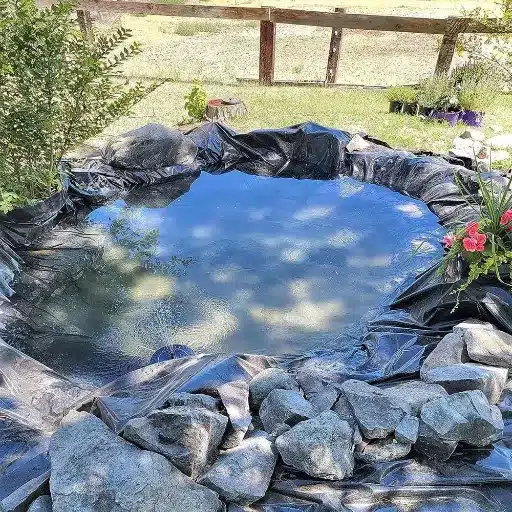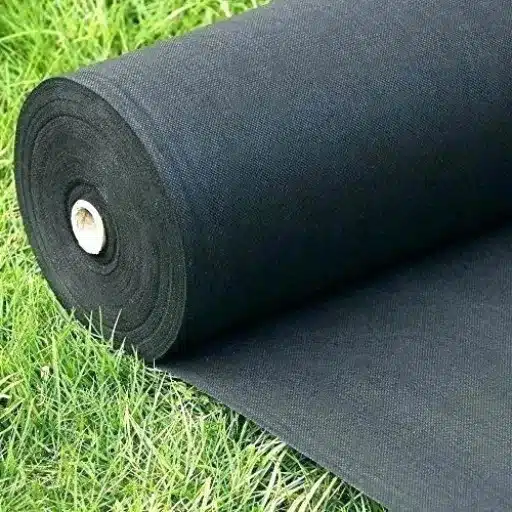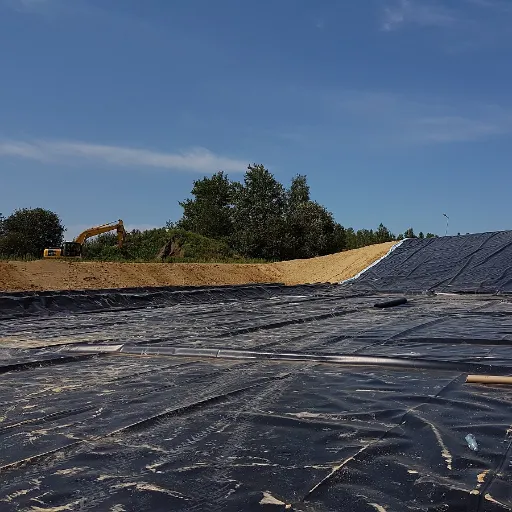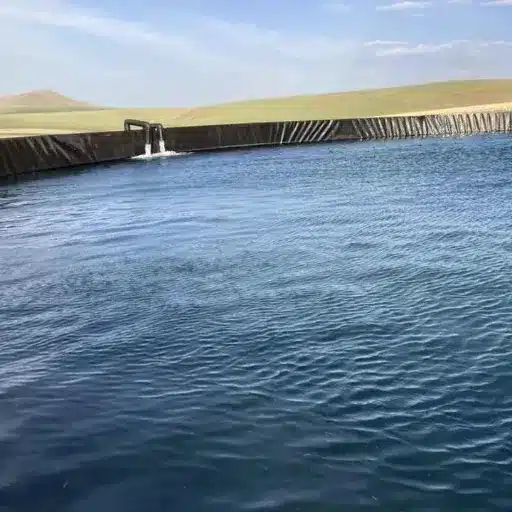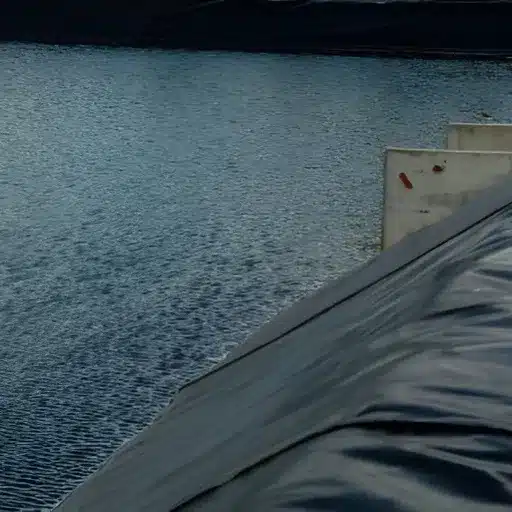A pond that is durable and efficient will require a mixture of planning and the right pond liner, which is one of the crucial factors. In the matter of eco-friendliness, strength, and flexibility, the 20-mil LLDPE (Linear Low-Density Polyethylene) pond liner is one of the best picks. This blog will present to you LLDPE pond liners’ merits, firstly, the thickness of 20-mil gives the right proportion of durability and pricing, and ultimately it can lead you to a long-lasting and eco-friendly pond. A tranquil backyard paradise or a functional water feature on a bigger scale, knowing about your pond liner options is a way to your pond’s survival for years to come. Keep on reading to learn about the unique characteristics and advantages of this revolutionary material.
Introduction to LLDPE Pond Liners
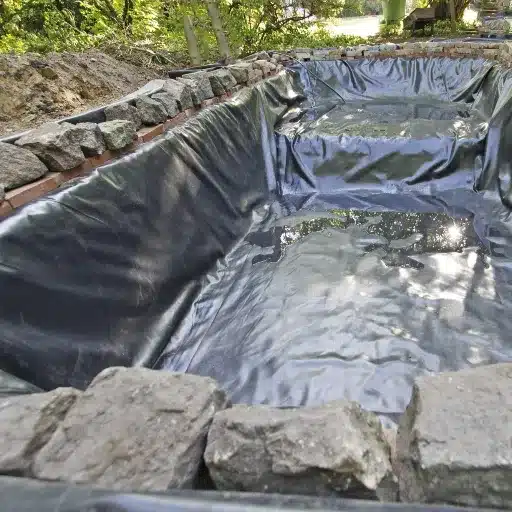
What is LLDPE?
Linear Low-Density Polyethylene (LLDPE) is a polymer that is not only versatile but also very strong, therefore it has a wide range of applications from this side, with one of them being the use of it in ponds as liners due to its flexible and environmentally-friendly properties. LLDPE is an advanced type of polyethylene that has branched short chains as its basic feature, granting it the distinct mechanical and chemical properties of having a much better strength and resistance to impacts than other polyethylene materials. LLDPE is not only strong but also very resistant to harsh environmental conditions, which is why it is often used in outdoor and water-related applications.
One of the main characteristics of LLDPE that makes it suitable for pond liners is its great flexibility which allows it to fit uneven surfaces easily and at the same time it maintains a high degree of puncture resistance. So, the solution created is a long-lasting one with very little risk of tears and consequently no environmental damage. LLDPE pond liners are usually between 20 and 40 mils thick, which is the perfect weight for the very light construction and at the same time the very high performance.
Why Choose LLDPE for Your Pond?
Durability and Flexibility
Among the characteristics of LLDPE pond liners are the great tensile strength and elongation properties of the material. This means that the natural ground movements like settling or slight shifts are tolerated without the risk of tearing or cracking. In comparison to HDPE (High-Density Polyethylene), LLDPE offers greater flexibility, which facilitates its use in areas with irregular shape or sloped projects.
UV and Chemical Resistance
LLDPE shows rather good resistance to UV rays and to the attacks of harmful chemicals. The fact that ponds are outdoor and therefore naturally exposed to sunlight for long hours is a major concern for their liners, but it will not be a problem for LLDPE ones as they will not lose their quality under the sun. Moreover, the material has a high resistance to the chemicals that usually come in contact with wastewater and fertilizers in the course of aquaculture and soil cultivation.
Benefits of Using LLDPE Pond Liners
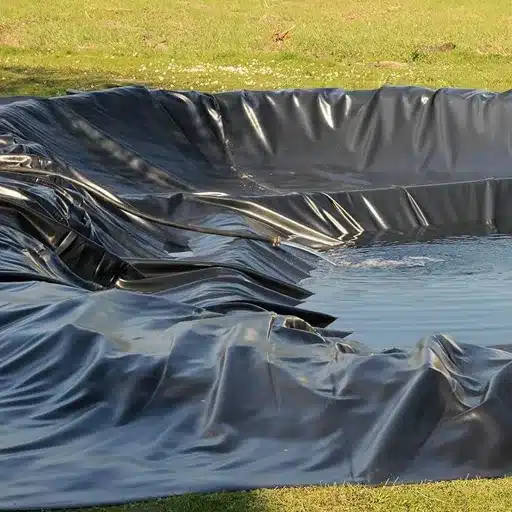
Durability and Longevity
It is the LLDPE pond liners that come to the top when talking about durability and lifespan. Up from high-quality linear low-density polyethylene, these liners have an incredible resistance against tearing, puncturing, and getting old by nature. Their wide temperature range, from extreme heat to frostiness, is the reason why they can easily live up to their area of use.
Research has indicated that LLDPE liners can have a lifespan of more than 20 years if the conditions are right, with UV exposure and maintenance as two major factors. Today’s LLDPE liners are usually the ones that undergo treatment with the help of UV light and antioxidants, which in turn greatly develop the sunlight and weathering resistance. On top of that, their ability to stand up against chemicals is one of the reasons why they are the go-to choice for chemicals, fertilizers, and oils in agriculture and industry without losing their quality.
Flexibility and Ease of Installation
LLDPE liners’ flexibility is a quality that sets them apart from all other liners, making them the best choice when it comes to the installation of liners in places where the environment and structural requirements vary. The very fact that they can be easily fitted to rough, slopy, or intricately designed terrains without losing functionality is one of their merits. The high tensile and elongation properties of LLDPE enable them to stretch and take the shape of the surface contours, thereby minimizing the chances of tearing or losing the fabric’s during installation.
Moreover, the introduction of new technology has led to a greater simplification of the application process. One of the present-day developments is in the form of large, prefabricated panels that minimize the number of field seams significantly and cut the installation time by 30% when compared to the older materials. Their light weight further extends the benefits of efficient transportation and handling thus reducing the labor costs and ensuring the project is done quicker.
Comparison with Other Pond Liner Materials
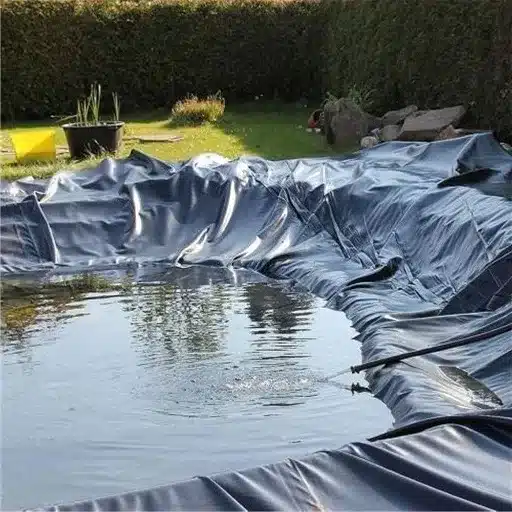
LLDPE vs. HDPE Pond Liners
| Feature | LLDPE | HDPE |
|---|---|---|
| Flexibility | More pliable, suitable for irregular contours and uneven floors. Minimizes risk of cracking or tearing during installation, especially in cold regions. | Less flexible, more rigid structure. |
| Durability | Extremely resistant to chemicals with long life cycle. | Toughest and most puncture resistant. Better for high loads and long-term UV exposure. |
| Thickness | Frequently supplied in thinner gauges (20-40 mils) while maintaining considerable strength. Advantageous for lightweight applications. | Usually made in higher thicknesses (30-120 mils). Appropriate for heavy-duty uses like industrial water containment. |
Choosing the Right Pond Liner Material
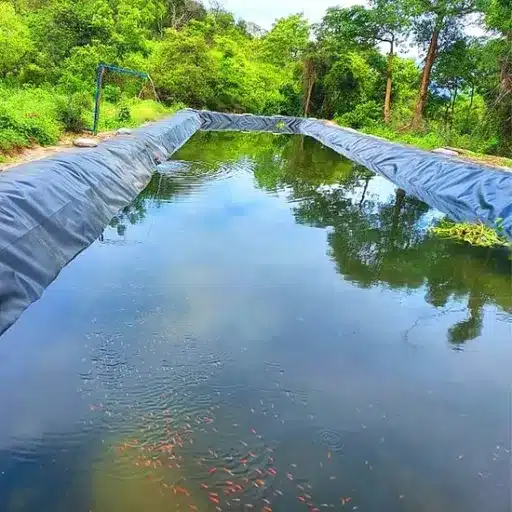
Durability and Longevity
LLDPE liners are durable and resistant to punctures and tears, thus being a feasible choice for projects where long-term reliability is required. Their lifespan is usually estimated to be 10 to 20 years if they are properly installed and protected from direct sunlight. What is more, they are quite resistant to UV and chemical damage. On the other hand, EPDM liners cut the most when it comes to longevity, with a lifespan of over 30 years in optimal conditions. They are particularly recommended for projects located in a place characterized by either extreme or fluctuating temperatures as they are able to retain their elasticity and integrity throughout time.
Flexibility
EPDM liners are sought after for their great flexibility that allows them to blend in with the character of an irregularly shaped pond and uneven ground. Thus, EPDM becomes the first option for tailor-made ponds or projects with complicated layouts. LLDPE liners are less flexible than EPDM but they can still conform to the water body’s gentle curves, although their use would be limited to simpler shapes and layouts.
Cost Efficiency
LLDPE pond liners are regularly less expensive at first—a square foot pricing is usually lower than the cost of EPDM liners. Recent market analysis shows that the average price of LLDPE liners is about $0.30 to $0.50 per square foot while that of EPDM interchangeable at $0.80 to more than $1.00 per square foot depending on thickness and quality. However, the higher initial expenditure on EPDM can be worth it in the end owing to the liner’s longer life and better performance in extreme weather conditions.
Installation Tips for LLDPE Pond Liners
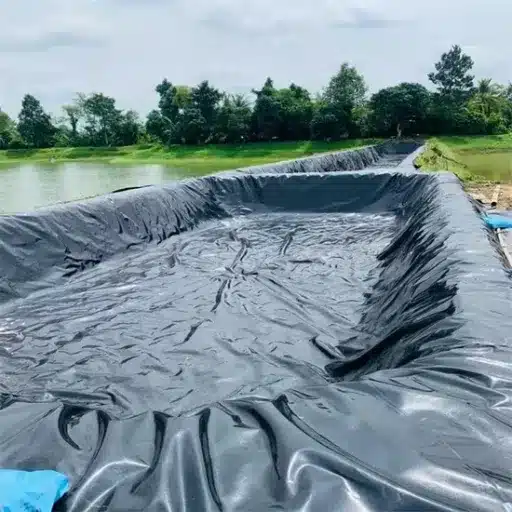
Preparation of the Pond Site
Site Selection and Planning:
Sunlight and zoning are major factors to consider when selecting a pond site. Locate the pond near a sunlit area with moderate sunlight and no nearby trees to limit debris. Flat or slightly sloped ground would be the easiest to build and maintain. Use wooden stakes and string to outline and size up the pond. Confirm the measurements are for the pond designed in the way and consider any landscaping features as well.
Excavation and Grading:
As you are digging, take care of the pond area and follow the desired depth and contours. An 18 to 36 inches depth is enough for most residential ponds, while very big or ponds placed in cold areas may need seasonal depths of 48 inches or more to keep them from freezing. For the most exact answer, check with the local authorities based on the climate. Pond walls should be graded uniformly to avoid sliding or uneven water pressure against the liner.
Removing Debris and Sharp Objects:
The liner of your pond can be punctured by any of the following: rocks, roots, or sharp objects found in the area where the pond is being excavated. Although research indicates that a 2-inch layer of sand can be added to increase protection against punctures and provide a smoother base, it is better to avoid such a situation in the first place.
Common Mistakes to Avoid
- Insufficient Site Preparation: If any sharp objects such as rocks, roots, or debris are not cleared from the pond base, they definitely will puncture the liner. Proper underlayment or geotextile fabric can reduce the risk of damage by as much as 80%, experts say.
- Improper Measurement: Incorrectly estimating the dimensions of the pond can lead to a liner that is either too small or that results in excessive waste being created. Be sure to measure the pond’s depth, width, and length with the utmost care, allowing for a margin of 1-2 feet for overlap and anchoring.
- Skipping Soil Compaction: Not compacting the soil base will eventually lead to shifting or creasing of the liner as a result of soil settling. If the soil is compacted, the risk of deformation is reduced by almost 60%, according to studies.
Maintenance of Your LLDPE Pond Liner
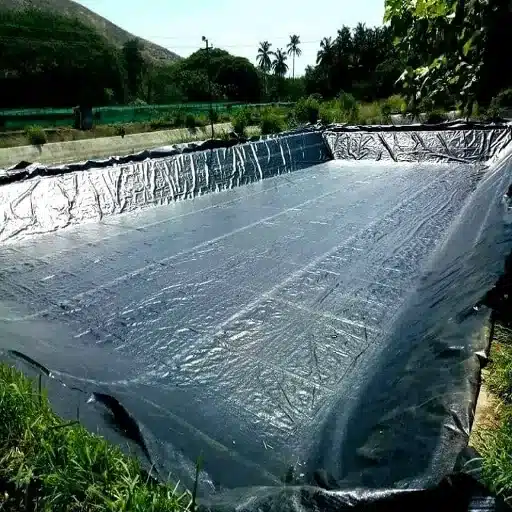
Routine Checks and Repairs
To get the maximum lifespan from your LLDPE pond liner, regular maintenance is the first step, and the same goes for its effective performance over time. Routine checks must include looking for signs of wear and tear, such as punctures, tears, or even stretching due to external factors like UV exposure, heavy equipment, or soil movement. It is advisable to have these inspections done at least biannually and after the occurrence of severe weather, as storms can very well cause the dislocation of liners or bring in debris that can lead to damage.
While doing the inspection, it would be wise to keep an eye on the areas near the seams and edges of the pond liner where leaks are most likely to happen. The use of non-invasive techniques such as visual inspections coupled with water loss monitoring is a quick and efficient way of discovering such issues. For instance, a small leak can cause an average water loss of 2–3% per day which may eventually impact water quality and efficiency.
Cleaning Tips for Longevity
Debris Removal on Regular Basis
There is a great possibility of organic matter, especially leaves and twigs, quickly getting piled up in your pond during fall. A pond net will come in handy in skimming the surface daily thus preventing this debris from deteriorating and releasing toxic gases into the water. Research indicates that algae growth could be reduced by as much as 40% through timely removal of debris.
A Pond Vacuum Should Be Invested In
Over time, silt and sediment become settled at the bottom of the pond. A pond vacuum is an ideal device for getting rid of this accumulation without causing any harm to the pond liner. Regular use of the vacuum can highly improve the clarity of the water and limit the costs of maintenance.
Keep Water Circulation Correct
A pump and filtration system of good quality will be capable of keeping the water in motion thus making it less likely for the water to be stagnant and for algae to bloom. Proper circulation, according to experts, is able to cut down mosquito breeding by 75% and also create a livelier aquatic environment which is good for both fish and plants.
Reference Sources
-
Global Plastic Sheeting Blog
- Title: Why LLDPE is a Good Choice for Fresh Water Pits
- Description: This blog discusses the benefits of LLDPE liners, including their flexibility, durability, and safety for aquatic life, making them ideal for ponds, reservoirs, and fresh water pits.
- Link: Global Plastic Sheeting Blog
-
Target Product Page
- Title: 20X20 FT LLDPE Pond Liners 20 Mil UV Resistant
- Description: This product page highlights the features of LLDPE pond liners, such as UV resistance, environmental safety for fish and plants, and prevention of soil contamination.
- Link: Target Product Page
-
Geomembrane Liner Guide
- Title: Geomembrane Liners: Applications and Benefits
- Description: This guide provides an overview of geomembrane liners, including LLDPE, and their applications in agriculture, aquaculture, and environmental protection.
- Link: Geomembrane Liner Guide
Frequently Asked Questions (FAQs)
What is an LLDPE pond liner?
An LLDPE pond liner is a type of liner that consists of a very flexible material, which is linear low-density polyethylene. It is highly durable, puncture-resistant, and UV resistant that is why it is often used in many pond applications such as fish ponds, koi ponds, water gardens etc.
Can LLDPE pond liners be used for large ponds?
LLDPE pond liners are suitable for large ponds and small ponds as well. Moreover, their flexibility enables them to be installed easily for all pond sizes, thus making them a reliable selection for pond construction due to their capability of holding the ground water effectively.
What thickness is recommended for an LLDPE pond liner?
A 20-mil LLDPE pond liner is widely suggested for most pond creation. Such thickness gives a well-balanced trait of flexibility and durability that makes it appropriate for koi ponds and water gardens while being resistive to punctures and tears.
Are LLDPE pond liners easy to install?
Indeed, LLDPE pond liners are easy to install. They can be shaped easily for different pond designs and especially help in creating a flat surface for your pond, making them user-friendly for DIY pond builders.
Can LLDPE pond liners be used for backyard waterfalls?
LLDPE pond liners are an excellent option for backyard waterfalls as the liners can be easily shaped to accommodate waterfalls and skimmers. The flexibility of LLDPE pond liners allows for seamless transitions between the pond and waterfall, thus, improving the aesthetic allure of your outdoor area.

